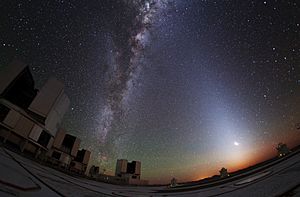Scattering facts for kids

Imagine throwing a ball at a wall. It bounces off in one direction. But what if you threw a handful of sand at the wall? The tiny grains would fly off in many different directions! This is a bit like what happens in scattering.
In science, scattering is when light, sound, or tiny particles hit something and then spread out in many different directions. It's like a billiard ball hitting a cluster of other balls, sending them all over the table. This is different from when something soaks up energy (called absorption), bounces it back neatly (like a mirror, which is reflection), or bends it as it passes through (like light through water, which is refraction).
Contents
What is Scattering?
Scattering is a very common event in nature. It happens when waves or particles bump into other particles or objects. When they hit, their path changes, and they get sent off in new directions. Think about how sunlight looks when it passes through a dusty room. You can see the light beams because the dust particles are scattering the light.
Why is the Sky Blue?
One of the best examples of scattering is why our sky looks blue! Sunlight is made up of all the colors of the rainbow. When sunlight enters Earth's atmosphere, it hits tiny gas molecules, mostly nitrogen and oxygen. These tiny molecules scatter blue light more than other colors. Because blue light is scattered in all directions, it makes the sky look blue to us. At sunrise or sunset, the sunlight has to travel through more of the atmosphere. Most of the blue light has already been scattered away, leaving more red and orange light to reach our eyes, which is why sunsets are often colorful.
Different Kinds of Scattering
Scientists have identified different types of scattering, depending on what is being scattered and what it hits. Here are a few examples:
- Rayleigh scattering: This is the type of scattering that makes the sky blue. It happens when light hits particles much smaller than its wavelength.
- Mie scattering: This occurs when light hits particles that are about the same size as its wavelength. This type of scattering is why clouds look white. The water droplets in clouds are larger than the gas molecules in the sky, and they scatter all colors of light equally, making the clouds appear white or gray.
- Compton scattering: This is a type of scattering that happens with very high-energy light, like X-rays or gamma rays, when they hit electrons. When this happens, the light loses some of its energy, and the electron gains energy and changes direction.
Scattering is important in many areas, from how we see the world around us to how scientists study tiny particles in space or inside atoms.
Images for kids
See also
 In Spanish: Dispersión (física) para niños
In Spanish: Dispersión (física) para niños


